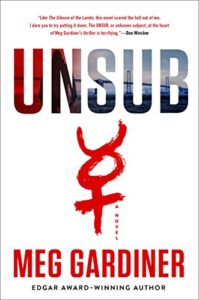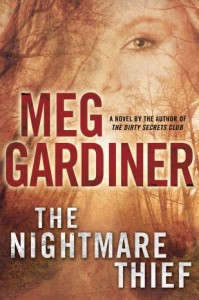JSB: I am on a research trip and will only have sketchy, if any, internet access today. So I’ve asked Meg Gardiner if she would step in for me. Meg is an Edgar Award winner whose new novel, UNSUB, is getting rave reviews. Like this one:
“Outstanding series launch… Taut pacing and sympathetic characters play against a terrifying villain, who will crawl beneath your skin and trouble your sleep. Thriller fans will eagerly await the sequel.” — Publishers Weekly, starred review
Plus, it’s just been announced that CBS is going to adapt UNSUB as a TV series!
UNSUB releases June 27, but you can pre-order at Amazon, Barnes & Noble, or Indiebound.
Welcome, Meg!
 UNSUB is about a legendary killer and the young cop who hunts him. In my thriller, the UNSUB—an unknown subject in a criminal investigation—starts killing again after twenty years, and Caitlin Hendrix must decipher his coded plan before he drags more innocents to the abyss.
UNSUB is about a legendary killer and the young cop who hunts him. In my thriller, the UNSUB—an unknown subject in a criminal investigation—starts killing again after twenty years, and Caitlin Hendrix must decipher his coded plan before he drags more innocents to the abyss.
The novel was sparked by the unsolved case that has haunted California for decades, and me since childhood: the Zodiac. That infamous UNSUB shot and stabbed seven people in the San Francisco Bay Area. The Zodiac sent dozens of messages to the police and media, including cryptograms that have never been broken. The terror wrought by the killings still lingers today.
I grew up in California, spooked by the knowledge that the Zodiac could strike at any time. Today, I’m spooked by the thought that the killer hasn’t been caught. The Zodiac could still be out there.
And, being a thriller writer, spooky thoughts lead me to spooky ideas. What if a terrifying cold case turned hot again? What if a killer who’d disappeared—as the Zodiac did—resumed killing decades later?
I turned that unnerving idea, that they-never-caught-him fear, into this novel.
In UNSUB, Bay Area sheriff’s detective Caitlin Hendrix is pulled into the chilling world of the serial killer known as the Prophet. This UNSUB posed his victims in garish crime scene displays, and marked their bodies with the ancient sign for Mercury. He’s given Caitlin nightmares since she was a small girl. Her father, Mack, was the lead detective on the original case. The investigation shattered Mack emotionally and tore his family apart.
To write the novel, I had to create the killer’s secret world. I delved into codes, puzzles, astrology, poetry, ancient symbolism—and 21st century hacking. The Prophet is a master of mind games. To stop him, Caitlin must do what her father couldn’t. She must decipher both the Prophet’s old, taunting messages and his strange new rhymes. What do the crime scene tableaus signify? What does the Mercury sign mean? And what is the Prophet’s end game?
Readers ask if I write to exorcise my demons. I don’t. As a writer, I take what frightens me and try to turn it into gripping fiction. I put my demons on the page, and turn them loose for readers to experience in the most exciting and suspenseful ways I can create.
UNSUB is a psychological thrill ride. Enjoy it.
But, if it gets you thinking about what’s out there, don’t turn off the lights.


